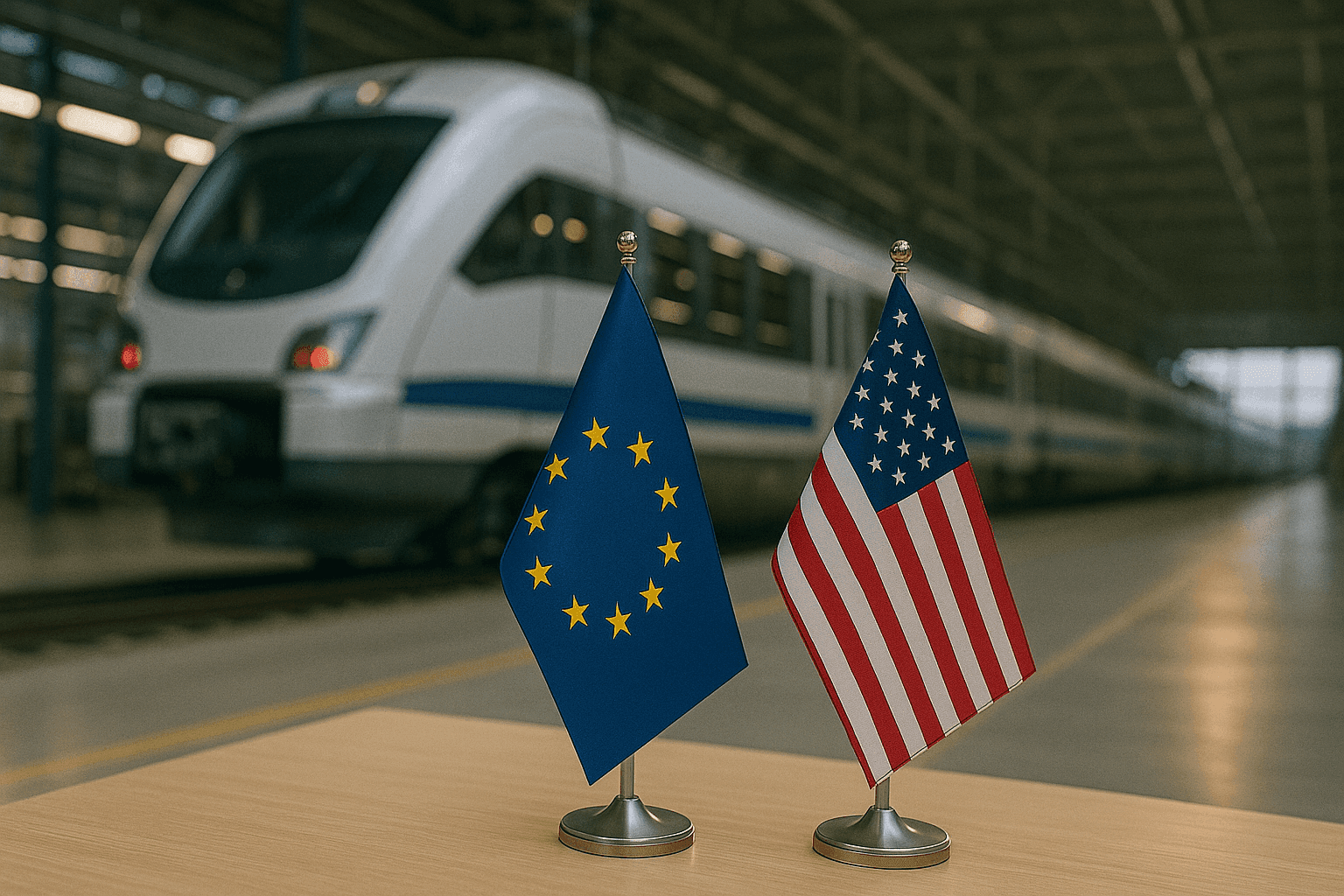A Turning Point for European Rail: What the New EU-US Trade Deal Means for Our Industry
The 15% import tariff offers long-awaited clarity for Europe’s rail sector. But success in the US still depends on mastering compliance, meeting local content rules, and building smart transatlantic partnerships.
- Home /
- EU-US Tariff Deal: What Companies Need to Prepare for Starting Today /
- Rail: Predictability at a Price
Clarity Through Cost: What Stability Means for Rail Exporters
As of Friday, 1 August 2025, the European Union and the United States have concluded a targeted trade agreement that is already being hailed as a stabilising force in an increasingly uncertain global market. While not devoid of compromises, the deal introduces a uniform 15% import tariff on a defined set of EU industrial goods entering the US, replacing a previously inconsistent and often punitive system of duties. For many sectors, this change is a welcome development. But for Europe’s rail industry, and particularly for those of us advising companies in this field, the consequences require closer scrutiny.
At H&Z, we are deeply embedded in the rail and broader machinery sectors. We work closely with manufacturers, suppliers, and investors across Europe, helping them navigate shifting regulatory landscapes and operational complexity. From that vantage point, this trade deal presents both opportunity and challenge, particularly for those involved in the export of trains, components, and systems to the United States.
Previously, most rail products faced tariffs between 0% and 5%, though European exporters were exposed to uncertainty due to temporary measures or politically motivated trade actions. With the new deal, this unpredictability is replaced by a single, stable tariff level.
What Does This Mean for European Train Exports?
For leading European manufacturers such as Siemens Mobility, Alstom, and Stadler Rail, who have significant operations or project portfolios in the United States, the uniform 15% tariff provides welcome clarity. Siemens, for example, has been producing passenger trains for the US market from its Sacramento facility for over a decade, including recent high-profile contracts for Amtrak and various state-level intercity services. Alstom is currently delivering high-speed trainsets for Amtrak’s Northeast Corridor and has expanded its US footprint through facilities like its Hornell plant in New York. Stadler Rail, similarly, operates a major site in Salt Lake City, Utah, supporting various US commuter and metro projects.
These companies already localise a substantial portion of their value chain to comply with “Buy America” provisions. However, they still rely on importing specialised components such as propulsion systems, bogies, and signalling hardware from their European operations. The new tariff rate may not be negligible, but it is manageable. More importantly, it is predictable. This provides a basis on which these firms can price contracts and negotiate with US buyers with greater confidence.
And confidence matters. The US is in the midst of a once-in-a-generation wave of infrastructure investment. From modernising metro systems in major cities to upgrading intercity rail, the demand for rail technology is real. European OEMs with proven experience in high-capacity urban and regional systems are well positioned to compete if they can navigate the costs and compliance burdens that remain.
Implications for Mid-Sized EU Suppliers
Beyond the large OEMs lies the equally critical ecosystem of specialist rail suppliers, many of them medium-sized firms based in Germany, Austria, Switzerland, France, and Italy. These companies provide the lifeblood of innovation in areas like train control, electrification, HVAC systems, and mechanical assemblies.
For these suppliers, the US has historically been a difficult market to access. Tariff instability, complex federal procurement rules, and tough certification standards created high entry barriers. While the new 15% tariff does not eliminate these hurdles, it does at least remove one: market access is now more calculable.
Yet challenges persist. The US rail market remains governed by strict safety and performance standards. Even if a German company can offer a superior axle system, it must still obtain certification from the Federal Railroad Administration (FRA) or other agencies. This process is costly, time-consuming, and uncertain. The new trade agreement does not harmonise regulatory frameworks or create mutual recognition. In that sense, technical compliance remains a critical gatekeeper.
Then there is the issue of local content rules. “Buy American” provisions have generally become more stringent, particularly in federally funded transit projects. US public transport authorities often demand that a significant portion (in some cases over 70%) of the value in any rolling stock procurement be sourced domestically. This places European suppliers in a bind: export and pay the tariff or localise and contend with labour and setup costs in a foreign market.
Some suppliers will respond by deepening their partnerships with US firms, forming joint ventures or licensing agreements. Others may take the more ambitious route of establishing their own local assembly or service units. What’s clear is that this trade agreement, while not radically transformative, may catalyse a new wave of strategic decision-making across the supply chain.
Strategic Considerations Going Forward
As a consulting partner to many industrial clients, H&Z views this agreement as an inflection point. It is not just a tariff deal; it is a signal of geoeconomic realism. The US is pursuing a policy of managed trade focused less on free movement and more on secure, bilateral relations. For European firms, particularly those in capital-intensive and regulated sectors like rail, the implication is that success in the US requires both technical excellence and geopolitical agility.
This moment also calls for strategic foresight. We encourage our clients to assess:
- How dependent are you on exports to the US, and where are your margin pressures most acute?
- Do you have US-certified products or the capability to achieve certification efficiently?
- Are there opportunities for you to form transatlantic partnerships that meet local content requirements while preserving your IP and cost structure?
These are the kinds of questions that demand not only operational insight, but also a clear understanding of policy dynamics and customer expectations.
Concluding Thoughts
In summary, the EU-US trade agreement of July 2025 brings welcome clarity to what had been a turbulent transatlantic environment. For Europe’s rail sector, it does not deliver all that was hoped for, but it does provide a framework upon which business can be built. The 15% import tariff may raise costs, but its consistency allows for better planning and risk management. The rules are known and the playing field, while still tilted, is at least visible.
As someone who has spent years advising rail and machinery clients on global market strategies, I see this as a moment not of triumph but of opportunity through preparation. The firms that move now towards compliance, localisation, and smart collaboration will be best positioned to thrive in the world this agreement defines.
At H&Z, we stand ready to support that journey.

